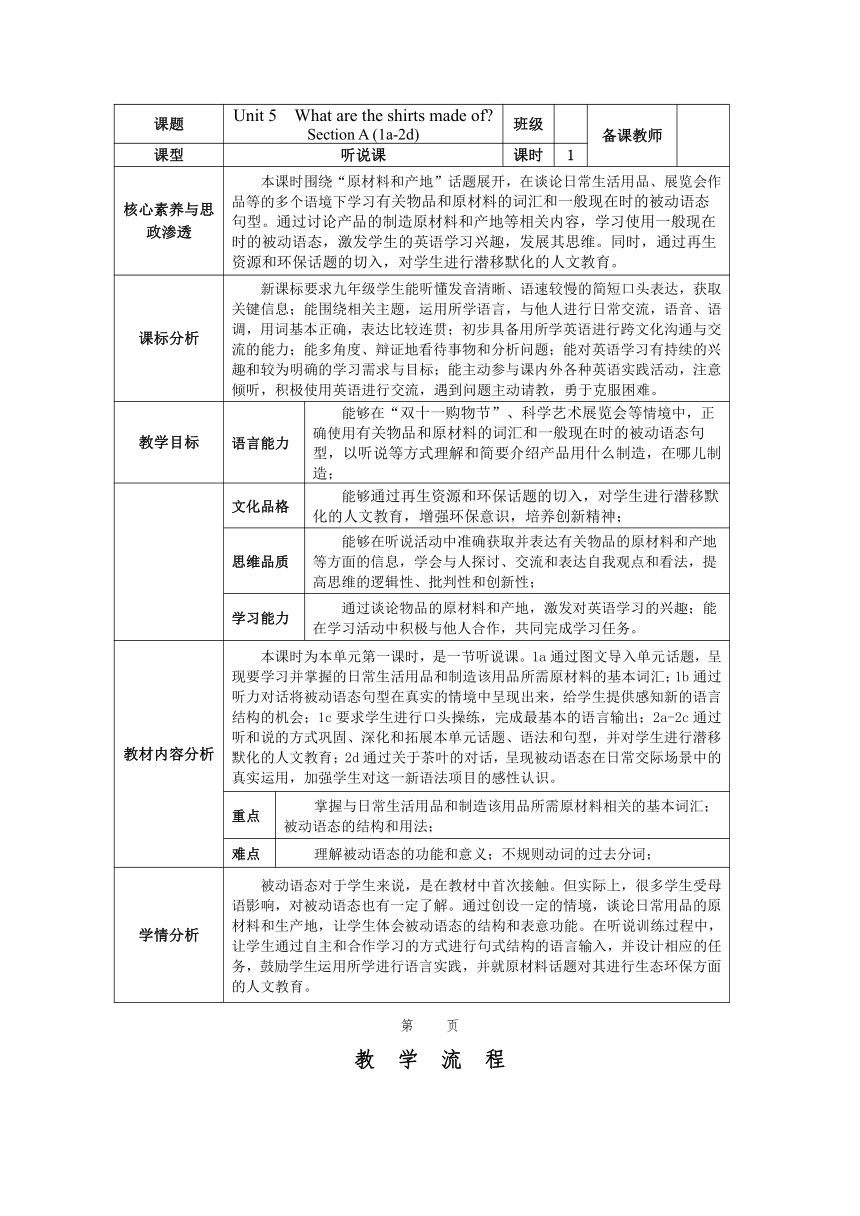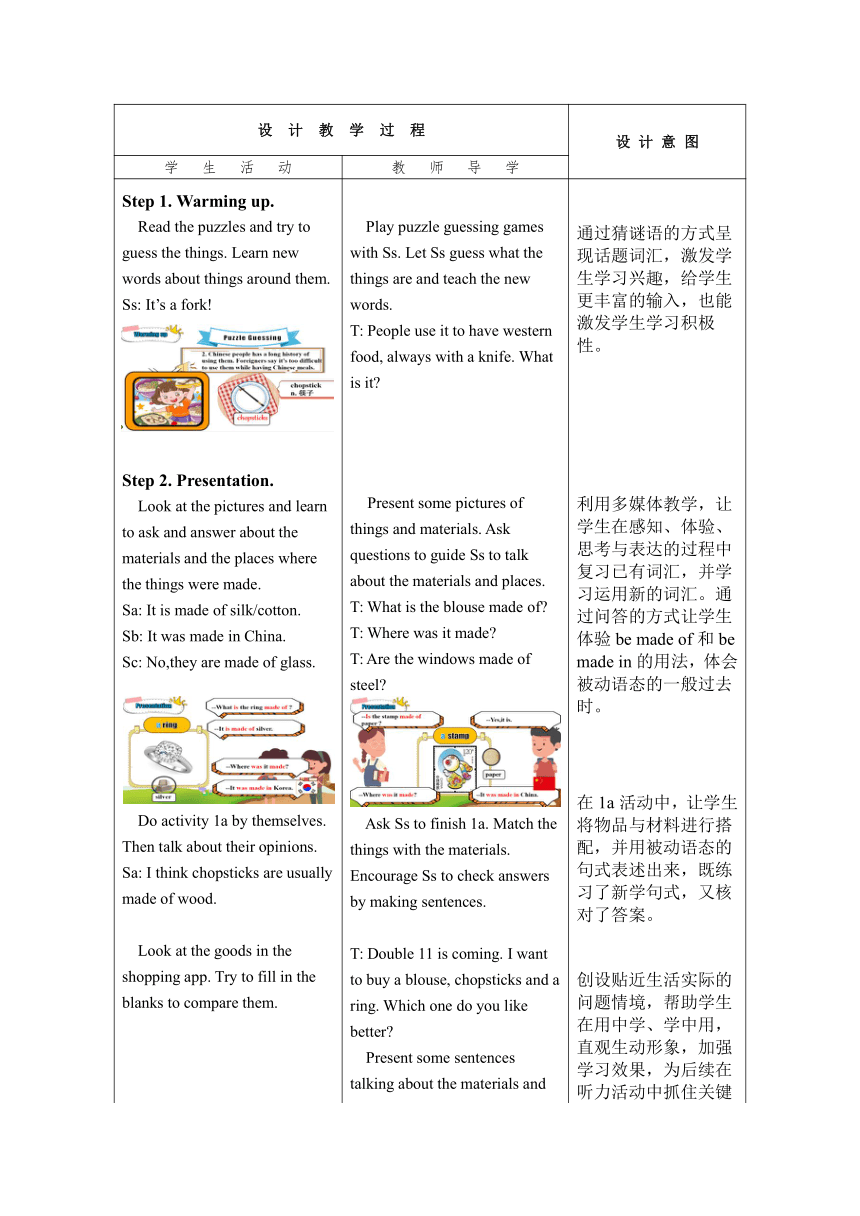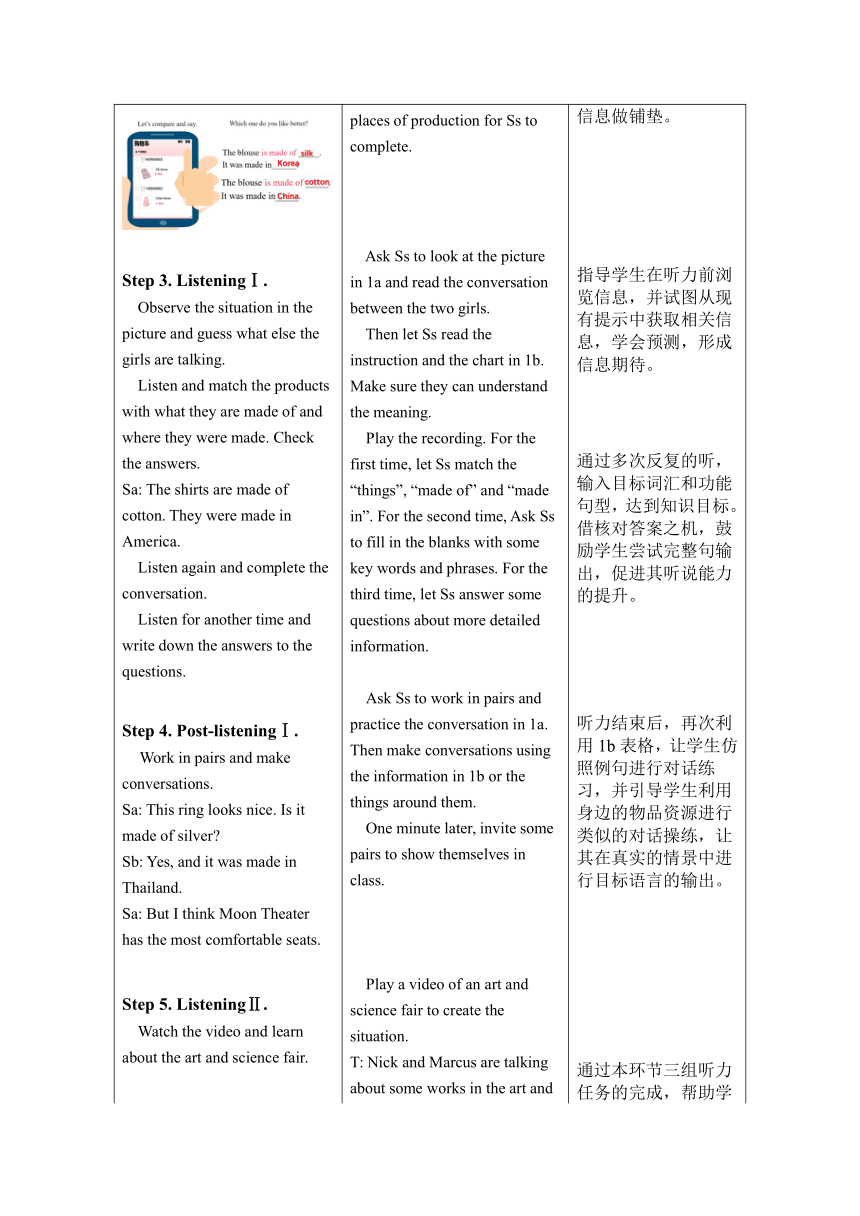【核心素养目标】Unit 5 What are the shirts made of Section A (1a-2d)表格式教案
文档属性
| 名称 | 【核心素养目标】Unit 5 What are the shirts made of Section A (1a-2d)表格式教案 |  | |
| 格式 | docx | ||
| 文件大小 | 858.1KB | ||
| 资源类型 | 教案 | ||
| 版本资源 | 人教新目标(Go for it)版 | ||
| 科目 | 英语 | ||
| 更新时间 | 2024-09-24 10:07:13 | ||
图片预览




文档简介
课题 Unit 5 What are the shirts made of Section A (1a-2d) 班级 备课教师
课型 听说课 课时 1
核心素养与思政渗透 本课时围绕“原材料和产地”话题展开,在谈论日常生活用品、展览会作品等的多个语境下学习有关物品和原材料的词汇和一般现在时的被动语态句型。通过讨论产品的制造原材料和产地等相关内容,学习使用一般现在时的被动语态,激发学生的英语学习兴趣,发展其思维。同时,通过再生资源和环保话题的切入,对学生进行潜移默化的人文教育。
课标分析 新课标要求九年级学生能听懂发音清晰、语速较慢的简短口头表达,获取关键信息;能围绕相关主题,运用所学语言,与他人进行日常交流,语音、语调,用词基本正确,表达比较连贯;初步具备用所学英语进行跨文化沟通与交流的能力;能多角度、辩证地看待事物和分析问题;能对英语学习有持续的兴趣和较为明确的学习需求与目标;能主动参与课内外各种英语实践活动,注意倾听,积极使用英语进行交流,遇到问题主动请教,勇于克服困难。
教学目标 语言能力 能够在“双十一购物节”、科学艺术展览会等情境中,正确使用有关物品和原材料的词汇和一般现在时的被动语态句型,以听说等方式理解和简要介绍产品用什么制造,在哪儿制造;
文化品格 能够通过再生资源和环保话题的切入,对学生进行潜移默化的人文教育,增强环保意识,培养创新精神;
思维品质 能够在听说活动中准确获取并表达有关物品的原材料和产地等方面的信息,学会与人探讨、交流和表达自我观点和看法,提高思维的逻辑性、批判性和创新性;
学习能力 通过谈论物品的原材料和产地,激发对英语学习的兴趣;能在学习活动中积极与他人合作,共同完成学习任务。
教材内容分析 本课时为本单元第一课时,是一节听说课。1a通过图文导入单元话题,呈现要学习并掌握的日常生活用品和制造该用品所需原材料的基本词汇;1b通过听力对话将被动语态句型在真实的情境中呈现出来,给学生提供感知新的语言结构的机会;1c要求学生进行口头操练,完成最基本的语言输出;2a-2c通过听和说的方式巩固、深化和拓展本单元话题、语法和句型,并对学生进行潜移默化的人文教育;2d通过关于茶叶的对话,呈现被动语态在日常交际场景中的真实运用,加强学生对这一新语法项目的感性认识。
重点 掌握与日常生活用品和制造该用品所需原材料相关的基本词汇;被动语态的结构和用法;
难点 理解被动语态的功能和意义;不规则动词的过去分词;
学情分析 被动语态对于学生来说,是在教材中首次接触。但实际上,很多学生受母语影响,对被动语态也有一定了解。通过创设一定的情境,谈论日常用品的原材料和生产地,让学生体会被动语态的结构和表意功能。在听说训练过程中,让学生通过自主和合作学习的方式进行句式结构的语言输入,并设计相应的任务,鼓励学生运用所学进行语言实践,并就原材料话题对其进行生态环保方面的人文教育。
第 页
教 学 流 程
设 计 教 学 过 程 设 计 意 图
学 生 活 动 教 师 导 学
Step 1. Warming up. Read the puzzles and try to guess the things. Learn new words about things around them. Ss: It’s a fork! Step 2. Presentation. Look at the pictures and learn to ask and answer about the materials and the places where the things were made. Sa: It is made of silk/cotton. Sb: It was made in China. Sc: No,they are made of glass. Do activity 1a by themselves. Then talk about their opinions. Sa: I think chopsticks are usually made of wood. Look at the goods in the shopping app. Try to fill in the blanks to compare them. Step 3. ListeningⅠ. Observe the situation in the picture and guess what else the girls are talking. Listen and match the products with what they are made of and where they were made. Check the answers. Sa: The shirts are made of cotton. They were made in America. Listen again and complete the conversation. Listen for another time and write down the answers to the questions. Step 4. Post-listeningⅠ. Work in pairs and make conversations. Sa: This ring looks nice. Is it made of silver Sb: Yes, and it was made in Thailand. Sa: But I think Moon Theater has the most comfortable seats. Step 5. ListeningⅡ. Watch the video and learn about the art and science fair. Listen to the T’s introduction to the fair. Try to guess the materials of the works. Sa: What’s the model plane made of Sb: Maybe it’s made of wood and glass. Listen and check the main topic of Nick and Marcus’ conversation. Try to talk about their reasons while checking answers. Listen again. Write short answers to the questions. Check the answers in class. Listen again and mark true or false. Talk about their reasons. Step 6. Post-listeningⅡ. Sa: What did you see at the art and science fair Sb: I saw... Sa: What is it made of/ from Sb: ... Step 7. Role-play. Look at the picture and guess what the conversation is about. Read the conversation in 2d and complete the mind map with some key information. Watch a video about how to reuse the used tea. Step 8. Summary. Have a summary of the phrases of “made” with the T’s help. Play puzzle guessing games with Ss. Let Ss guess what the things are and teach the new words. T: People use it to have western food, always with a knife. What is it Present some pictures of things and materials. Ask questions to guide Ss to talk about the materials and places. T: What is the blouse made of T: Where was it made T: Are the windows made of steel Ask Ss to finish 1a. Match the things with the materials. Encourage Ss to check answers by making sentences. T: Double 11 is coming. I want to buy a blouse, chopsticks and a ring. Which one do you like better Present some sentences talking about the materials and places of production for Ss to complete. Ask Ss to look at the picture in 1a and read the conversation between the two girls. Then let Ss read the instruction and the chart in 1b. Make sure they can understand the meaning. Play the recording. For the first time, let Ss match the “things”, “made of” and “made in”. For the second time, Ask Ss to fill in the blanks with some key words and phrases. For the third time, let Ss answer some questions about more detailed information. Ask Ss to work in pairs and practice the conversation in 1a. Then make conversations using the information in 1b or the things around them. One minute later, invite some pairs to show themselves in class. Play a video of an art and science fair to create the situation. T: Nick and Marcus are talking about some works in the art and science fair. T: All the works were made by university students. They came up with some interesting and creative ideas. Let Ss read the main ideas in 2a and make sure they can understand the meaning. Play the recording and let Ss choose the right main idea. Before the second time, let Ss read the questions in 2b and make sure they can understand the meaning. Then provide some statements to let Ss make judgments. Ask Ss to work with partners and make conversations using the information in 2a and 2b. Encourage them to imagine other works which can be shown in the fair and talk about them. T: What are they doing (They are picking the leaves of tea.) T: How much do you know about tea Ask Ss to read the conversation after the recording and explain some language points. T: It is not easy to make good tea. Can we reuse the used tea T: Turn waste into wealth. 通过猜谜语的方式呈现话题词汇,激发学生学习兴趣,给学生更丰富的输入,也能激发学生学习积极性。 利用多媒体教学,让学生在感知、体验、思考与表达的过程中复习已有词汇,并学习运用新的词汇。通过问答的方式让学生体验be made of和be made in的用法,体会被动语态的一般过去时。 在1a活动中,让学生将物品与材料进行搭配,并用被动语态的句式表述出来,既练习了新学句式,又核对了答案。 创设贴近生活实际的问题情境,帮助学生在用中学、学中用,直观生动形象,加强学习效果,为后续在听力活动中抓住关键信息做铺垫。 指导学生在听力前浏览信息,并试图从现有提示中获取相关信息,学会预测,形成信息期待。 通过多次反复的听,输入目标词汇和功能句型,达到知识目标。借核对答案之机,鼓励学生尝试完整句输出,促进其听说能力的提升。 听力结束后,再次利用1b表格,让学生仿照例句进行对话练习,并引导学生利用身边的物品资源进行类似的对话操练,让其在真实的情景中进行目标语言的输出。 通过本环节三组听力任务的完成,帮助学生创设更多机会感知被动语态的使用,并引导其养成听前审题、听中记录关键信息、听后检查的良好习惯,渗透听力技能教学,提升语言能力和学习能力。 通过追问的方式,让学生思考平常的飞机模型和油画都是什么制成的,而本题中制作材料又是什么,引导学生关注环保和再生资源。 为学生创设机会进行口语输出和合作学习,帮助学生复习巩固含有一般现在时态被动语态的目标语言,并鼓励其大胆想象。 读前进行话题和词汇准备。通过思维导图,引导学生对对话从整体感知到细节理解,就“茶”的话题进行讨论和梳理,做到最大程度的掌握。 通过增加视频资源,再次引导学生关注环保和再生资源,促进文化意识的增强。 总结本课涉及到的made短语,强化被动语态的巩固。
第 页
课 时 达 标 检 测
Ⅰ. 补全句子。 这个飞机模型是用木头做的。 The model plane ____ ______ _____wood. 葡萄酒是由葡萄酿成的。 Wine _____ _____ ______ grapes. 这些汽车是在上海制造的。 These cars ____ _____ _____ Shanghai. 这些蛋糕是我姐姐昨晚制作的。 These cakes _____ ______ ____ my sister last night. Ⅱ. 选择题。 ( )5.This pair of shoes____hand,and it____very comfortable. A.is made by;feels B.is made from;is felt C.is made of;feels ( )6.As a wonderful volleyball player,Zhu Ting is known _____people all over the world. A.to B.as C.for ( )7.Nowadays,WeChat Pay is______used in cities,towns and villages. A.hardly B.widely C.badly ( )8.____I know,more and more people in the world are learning Chinese. A.As well as B.As often as C.As far as ( )9.Your gloves should be made____leather,for they feel soft and smooth. A.in B.on C.of Ⅲ. 补全对话。 A:Hello,Mrs.Smith!Welcome to my house. B:Thanks for your invitation,Mrs.King. A:10. B:Sure. A:11. B:Some Pu'er would be great,thanks. A:Sure.I just got some from my Chinese friend.He is from Yunnan and he bought it in a shop there. B:Oh,12. A:You're right.Chinese tea is drunk by people all over the world. B:Wow,this cup is beautiful and a little heavy.13. A:It is made of silver.I have many tea sets like this.14. B:Sounds like a great hobby. A.What's it made of? B.How much is it? C.Where was it made? D.What kind of tea would you like? E.I'm interested in collecting them. F.Please have a seat and would you like some tea? G.I know China is famous for tea.
第 页
课 时 教 学 设 计 尾 页
板 书 设 计
Unit 5 What are the shirts made of (Section A 1a-2d) Unit 5.What are the shirts made of?Section A(1a-2d)
作 业 设 计
Level A Design a product which can be shown in the art and science fair. Make a card about it with a picture and a short introduction about what it is made of and where it was made.
Level B Write a short passage to introduce Chinese tea to foreigners based on 2d.
教 学 反 思
第 页
课型 听说课 课时 1
核心素养与思政渗透 本课时围绕“原材料和产地”话题展开,在谈论日常生活用品、展览会作品等的多个语境下学习有关物品和原材料的词汇和一般现在时的被动语态句型。通过讨论产品的制造原材料和产地等相关内容,学习使用一般现在时的被动语态,激发学生的英语学习兴趣,发展其思维。同时,通过再生资源和环保话题的切入,对学生进行潜移默化的人文教育。
课标分析 新课标要求九年级学生能听懂发音清晰、语速较慢的简短口头表达,获取关键信息;能围绕相关主题,运用所学语言,与他人进行日常交流,语音、语调,用词基本正确,表达比较连贯;初步具备用所学英语进行跨文化沟通与交流的能力;能多角度、辩证地看待事物和分析问题;能对英语学习有持续的兴趣和较为明确的学习需求与目标;能主动参与课内外各种英语实践活动,注意倾听,积极使用英语进行交流,遇到问题主动请教,勇于克服困难。
教学目标 语言能力 能够在“双十一购物节”、科学艺术展览会等情境中,正确使用有关物品和原材料的词汇和一般现在时的被动语态句型,以听说等方式理解和简要介绍产品用什么制造,在哪儿制造;
文化品格 能够通过再生资源和环保话题的切入,对学生进行潜移默化的人文教育,增强环保意识,培养创新精神;
思维品质 能够在听说活动中准确获取并表达有关物品的原材料和产地等方面的信息,学会与人探讨、交流和表达自我观点和看法,提高思维的逻辑性、批判性和创新性;
学习能力 通过谈论物品的原材料和产地,激发对英语学习的兴趣;能在学习活动中积极与他人合作,共同完成学习任务。
教材内容分析 本课时为本单元第一课时,是一节听说课。1a通过图文导入单元话题,呈现要学习并掌握的日常生活用品和制造该用品所需原材料的基本词汇;1b通过听力对话将被动语态句型在真实的情境中呈现出来,给学生提供感知新的语言结构的机会;1c要求学生进行口头操练,完成最基本的语言输出;2a-2c通过听和说的方式巩固、深化和拓展本单元话题、语法和句型,并对学生进行潜移默化的人文教育;2d通过关于茶叶的对话,呈现被动语态在日常交际场景中的真实运用,加强学生对这一新语法项目的感性认识。
重点 掌握与日常生活用品和制造该用品所需原材料相关的基本词汇;被动语态的结构和用法;
难点 理解被动语态的功能和意义;不规则动词的过去分词;
学情分析 被动语态对于学生来说,是在教材中首次接触。但实际上,很多学生受母语影响,对被动语态也有一定了解。通过创设一定的情境,谈论日常用品的原材料和生产地,让学生体会被动语态的结构和表意功能。在听说训练过程中,让学生通过自主和合作学习的方式进行句式结构的语言输入,并设计相应的任务,鼓励学生运用所学进行语言实践,并就原材料话题对其进行生态环保方面的人文教育。
第 页
教 学 流 程
设 计 教 学 过 程 设 计 意 图
学 生 活 动 教 师 导 学
Step 1. Warming up. Read the puzzles and try to guess the things. Learn new words about things around them. Ss: It’s a fork! Step 2. Presentation. Look at the pictures and learn to ask and answer about the materials and the places where the things were made. Sa: It is made of silk/cotton. Sb: It was made in China. Sc: No,they are made of glass. Do activity 1a by themselves. Then talk about their opinions. Sa: I think chopsticks are usually made of wood. Look at the goods in the shopping app. Try to fill in the blanks to compare them. Step 3. ListeningⅠ. Observe the situation in the picture and guess what else the girls are talking. Listen and match the products with what they are made of and where they were made. Check the answers. Sa: The shirts are made of cotton. They were made in America. Listen again and complete the conversation. Listen for another time and write down the answers to the questions. Step 4. Post-listeningⅠ. Work in pairs and make conversations. Sa: This ring looks nice. Is it made of silver Sb: Yes, and it was made in Thailand. Sa: But I think Moon Theater has the most comfortable seats. Step 5. ListeningⅡ. Watch the video and learn about the art and science fair. Listen to the T’s introduction to the fair. Try to guess the materials of the works. Sa: What’s the model plane made of Sb: Maybe it’s made of wood and glass. Listen and check the main topic of Nick and Marcus’ conversation. Try to talk about their reasons while checking answers. Listen again. Write short answers to the questions. Check the answers in class. Listen again and mark true or false. Talk about their reasons. Step 6. Post-listeningⅡ. Sa: What did you see at the art and science fair Sb: I saw... Sa: What is it made of/ from Sb: ... Step 7. Role-play. Look at the picture and guess what the conversation is about. Read the conversation in 2d and complete the mind map with some key information. Watch a video about how to reuse the used tea. Step 8. Summary. Have a summary of the phrases of “made” with the T’s help. Play puzzle guessing games with Ss. Let Ss guess what the things are and teach the new words. T: People use it to have western food, always with a knife. What is it Present some pictures of things and materials. Ask questions to guide Ss to talk about the materials and places. T: What is the blouse made of T: Where was it made T: Are the windows made of steel Ask Ss to finish 1a. Match the things with the materials. Encourage Ss to check answers by making sentences. T: Double 11 is coming. I want to buy a blouse, chopsticks and a ring. Which one do you like better Present some sentences talking about the materials and places of production for Ss to complete. Ask Ss to look at the picture in 1a and read the conversation between the two girls. Then let Ss read the instruction and the chart in 1b. Make sure they can understand the meaning. Play the recording. For the first time, let Ss match the “things”, “made of” and “made in”. For the second time, Ask Ss to fill in the blanks with some key words and phrases. For the third time, let Ss answer some questions about more detailed information. Ask Ss to work in pairs and practice the conversation in 1a. Then make conversations using the information in 1b or the things around them. One minute later, invite some pairs to show themselves in class. Play a video of an art and science fair to create the situation. T: Nick and Marcus are talking about some works in the art and science fair. T: All the works were made by university students. They came up with some interesting and creative ideas. Let Ss read the main ideas in 2a and make sure they can understand the meaning. Play the recording and let Ss choose the right main idea. Before the second time, let Ss read the questions in 2b and make sure they can understand the meaning. Then provide some statements to let Ss make judgments. Ask Ss to work with partners and make conversations using the information in 2a and 2b. Encourage them to imagine other works which can be shown in the fair and talk about them. T: What are they doing (They are picking the leaves of tea.) T: How much do you know about tea Ask Ss to read the conversation after the recording and explain some language points. T: It is not easy to make good tea. Can we reuse the used tea T: Turn waste into wealth. 通过猜谜语的方式呈现话题词汇,激发学生学习兴趣,给学生更丰富的输入,也能激发学生学习积极性。 利用多媒体教学,让学生在感知、体验、思考与表达的过程中复习已有词汇,并学习运用新的词汇。通过问答的方式让学生体验be made of和be made in的用法,体会被动语态的一般过去时。 在1a活动中,让学生将物品与材料进行搭配,并用被动语态的句式表述出来,既练习了新学句式,又核对了答案。 创设贴近生活实际的问题情境,帮助学生在用中学、学中用,直观生动形象,加强学习效果,为后续在听力活动中抓住关键信息做铺垫。 指导学生在听力前浏览信息,并试图从现有提示中获取相关信息,学会预测,形成信息期待。 通过多次反复的听,输入目标词汇和功能句型,达到知识目标。借核对答案之机,鼓励学生尝试完整句输出,促进其听说能力的提升。 听力结束后,再次利用1b表格,让学生仿照例句进行对话练习,并引导学生利用身边的物品资源进行类似的对话操练,让其在真实的情景中进行目标语言的输出。 通过本环节三组听力任务的完成,帮助学生创设更多机会感知被动语态的使用,并引导其养成听前审题、听中记录关键信息、听后检查的良好习惯,渗透听力技能教学,提升语言能力和学习能力。 通过追问的方式,让学生思考平常的飞机模型和油画都是什么制成的,而本题中制作材料又是什么,引导学生关注环保和再生资源。 为学生创设机会进行口语输出和合作学习,帮助学生复习巩固含有一般现在时态被动语态的目标语言,并鼓励其大胆想象。 读前进行话题和词汇准备。通过思维导图,引导学生对对话从整体感知到细节理解,就“茶”的话题进行讨论和梳理,做到最大程度的掌握。 通过增加视频资源,再次引导学生关注环保和再生资源,促进文化意识的增强。 总结本课涉及到的made短语,强化被动语态的巩固。
第 页
课 时 达 标 检 测
Ⅰ. 补全句子。 这个飞机模型是用木头做的。 The model plane ____ ______ _____wood. 葡萄酒是由葡萄酿成的。 Wine _____ _____ ______ grapes. 这些汽车是在上海制造的。 These cars ____ _____ _____ Shanghai. 这些蛋糕是我姐姐昨晚制作的。 These cakes _____ ______ ____ my sister last night. Ⅱ. 选择题。 ( )5.This pair of shoes____hand,and it____very comfortable. A.is made by;feels B.is made from;is felt C.is made of;feels ( )6.As a wonderful volleyball player,Zhu Ting is known _____people all over the world. A.to B.as C.for ( )7.Nowadays,WeChat Pay is______used in cities,towns and villages. A.hardly B.widely C.badly ( )8.____I know,more and more people in the world are learning Chinese. A.As well as B.As often as C.As far as ( )9.Your gloves should be made____leather,for they feel soft and smooth. A.in B.on C.of Ⅲ. 补全对话。 A:Hello,Mrs.Smith!Welcome to my house. B:Thanks for your invitation,Mrs.King. A:10. B:Sure. A:11. B:Some Pu'er would be great,thanks. A:Sure.I just got some from my Chinese friend.He is from Yunnan and he bought it in a shop there. B:Oh,12. A:You're right.Chinese tea is drunk by people all over the world. B:Wow,this cup is beautiful and a little heavy.13. A:It is made of silver.I have many tea sets like this.14. B:Sounds like a great hobby. A.What's it made of? B.How much is it? C.Where was it made? D.What kind of tea would you like? E.I'm interested in collecting them. F.Please have a seat and would you like some tea? G.I know China is famous for tea.
第 页
课 时 教 学 设 计 尾 页
板 书 设 计
Unit 5 What are the shirts made of (Section A 1a-2d) Unit 5.What are the shirts made of?Section A(1a-2d)
作 业 设 计
Level A Design a product which can be shown in the art and science fair. Make a card about it with a picture and a short introduction about what it is made of and where it was made.
Level B Write a short passage to introduce Chinese tea to foreigners based on 2d.
教 学 反 思
第 页
同课章节目录
- Unit 1 How can we become good learners.
- Section A
- Section B
- Unit 2 I think that mooncakes are delicious!
- Section A
- Section B
- Unit 3 Could you please tell me where the restroom
- Section A
- Section B
- Unit 4 I used to be afraid of the dark.
- Section A
- Section B
- Unit 5 What are the shirts made of?
- Section A
- Section B
- Review of Units 1-5
- Unit 6 When was it invented?
- Section A
- Section B
- Unit 7 Teenagers should be allowed to choose their
- Section A
- Section B
- Unit 8 It must belong to Carla.
- Section A
- Section B
- Unit 9 I like music that I can dance to.
- Section A
- Section B
- Unit 10 You're supposed to shake hands.
- Section A
- Section B
- Review of Units 6-10
- Unit 11 Sad movies make me cry.
- Section A
- Section B
- Unit 12 Life is full of the unexpected
- Section A
- Section B
- Unit 13 We're trying to save the earth!
- Section A
- Section B
- Unit 14 I remember meeting all of you in Grade 7.
- Section A
- Section B
- Review of Units 11-14
